| Listing 1 - 10 of 10 |
Sort by
|
Book
ISBN: 9004320296 9789004320291 9789004335387 9004335382 Year: 2017 Publisher: Leiden Boston
Abstract | Keywords | Export | Availability | Bookmark
 Loading...
Loading...Choose an application
- Reference Manager
- EndNote
- RefWorks (Direct export to RefWorks)
In Ammianus Marcellinus: An Annotated Bibliography, 1474 to the Present, Fred W. Jenkins surveys scholarship on Ammianus from the editio princeps to the present. Included are bibliographies, editions, translations, commentaries, concordances and indexes, Web sites, and secondary scholarship in many languages.
Ammianus Marcellinus --- Ammianus Marcellinus. --- Ammianus, --- E-books --- Ammien Marcellin
Book
ISBN: 9788323380498 832338049X 9788323328452 8323328455 Year: 2009 Publisher: Krákow Jagiellonian University Press
Abstract | Keywords | Export | Availability | Bookmark
 Loading...
Loading...Choose an application
- Reference Manager
- EndNote
- RefWorks (Direct export to RefWorks)
Nach fast 300 Jahren, die seit der Verfassung der Annales durch Tacitus vergingen, erlebt die römische Historiographie, ähnlich wie die gesamte griechisch-römische Kultur, im 4. Jahrhundert ihre erneute Blütezeit. Der bekannteste Geschichtsschreiber in dieser Periode war ein Grieche Ammianus Marcellinus. Die Geschichtswerke des Nicomachus Flavianus, der seine Annales dem Kaiser Theodosius widmete, sowie der Autoren des 5. Jahrhunderts, die möglicherweise Ammians Res Gestae fortsetzten, wie etwa Sulpicius Aleksander oder Frigeridus sind hingegen völlig verloren gegangen. Im griechischen Bereich
Emperors --- Ammianus Marcellinus. --- Ammien Marcellin --- Rome --- History --- Historiography.
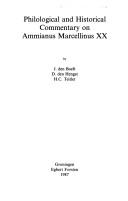
ISBN: 9069800128 9060880382 9069800861 9069801205 9004123350 9004142142 9789004162129 9789004180376 9789004215993 9004162127 9004180370 9789069800127 9789069800868 9789004142145 9781429452632 1429452633 9781433703928 1433703920 1280867507 9786610867509 Year: 1972 Publisher: Groningen Groningen Leiden Bouma's Boekhuis Forsten Brill
Abstract | Keywords | Export | Availability | Bookmark
 Loading...
Loading...Choose an application
- Reference Manager
- EndNote
- RefWorks (Direct export to RefWorks)
This is a commentary on Book XXV of the Res Gestae by the fourth century historian Ammianus Marcellinus. The commentary discusses philological, literary, linguistic and historical problems in the Latin text.
871 AMMIANUS MARCELLINUS
---
Latijnse literatuur--AMMIANUS MARCELLINUS
---
871 AMMIANUS MARCELLINUS Latijnse literatuur--AMMIANUS MARCELLINUS
---
Ammianus Marcellinus
---
Ammianus Marcellinus.
---
Valentinian
---
Valens,
---
Res gestae (Ammianus Marcellinus).
---
Ammianus,
---
Ammien Marcellin.
---
Valens
---
Valentinian,
---
Valentinien
---
Ammianus
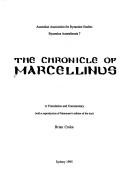
ISSN: 07253079 ISBN: 0959362665 9780959362664 9789004344631 9004344632 9789004353220 Year: 1995 Volume: 7 Publisher: Sydney Australian Association for Byzantine Studies
Abstract | Keywords | Export | Availability | Bookmark
 Loading...
Loading...Choose an application
- Reference Manager
- EndNote
- RefWorks (Direct export to RefWorks)
Marcellinus,
---
Byzantine Empire
---
Empire byzantin
---
History
---
Sources
---
Histoire
---
Kommentar.
---
Marcellinus (Comes).
---
Marcellinus
Book
ISBN: 9789004261532 9004261532 1306210208 9004267875 9781306210201 9789004267879 Year: 2013 Publisher: Brill
Abstract | Keywords | Export | Availability | Bookmark
 Loading...
Loading...Choose an application
- Reference Manager
- EndNote
- RefWorks (Direct export to RefWorks)
Book 29 opens with the judicial terror in Antioch following the discovery of a plot against the emperor in the East, Valens, who played an active role in hunting down and executing the culprits. The account of these internal troubles is balanced by two long chapters at the end of the book dealing with warfare in Africa and Central Europe. The general Theodosius mercilessly crushed the revolt of the Moorish prince Firmus, while the emperor in the West, Valentinian, had to deal with violent invasions of the Quadi and the Sarmatians. The two central chapters are devoted to different aspects of Valentinian’s character, his cruelty on the one hand, his diligence in reinforcing the border defenses on the other.
Ammianus Marcellinus. --- Rome --- History --- Historiography. --- Histoire --- Historiographie --- Ammien Marcellin, --- Ammien Marcellin (0330?-0400?). --- Critique et interprétation. --- Rerum gestarum libri (Ammianus Marcellinus). --- 284-476. --- Rome (Empire). --- Historiography --- Ammien Marcellin
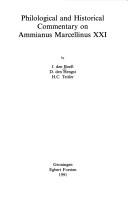
ISBN: 9789004299955 9789004353817 9789004251496 9060880358 9060880528 906088065X 9069800446 9789069800868 9789069801209 9789004123359 9789004142145 9789004163461 9789004180376 9789004215993 9789004261532 9060880358 9060880528 906088065X 9069800446 9789069800868 9069801205 9004123350 9789004142145 9789004163461 9789004180376 9789069800448 9004163468 9789004162129 9004162127 9004180370 9004215999 9004299955 900435381X 9789060880722 9786611939878 1281939870 9047423992 9786611936709 1281936707 9047421515 9786613356932 1283356937 9004224025 9786612951466 900418838X 1282951467 9004300929 9004353828 9789004224025 9789060880654 9069800861 9789060880524 9789047423997 9781281939876 6611939873 9789047421511 9781281936707 661193670X 9789004188389 9781282951464 661295146X 9060880722 9789004353824 9789004300927 Year: 2015 Volume: 289 Publisher: Leiden ;Boston Brill.
Abstract | Keywords | Export | Availability | Bookmark
 Loading...
Loading...Choose an application
- Reference Manager
- EndNote
- RefWorks (Direct export to RefWorks)
This is the final volume in the series of commentaries on Ammianus' Res Gestae . The last book of Ammianus Marcellinus’ Res Gestae is the most important source for a momentous event in European history: the invasion of the Goths across the Danube border into the Roman Empire and the ensuing battle of Adrianople (378 CE), in which a Roman army was annihilated and the emperor Valens lost his life. Many contemporaries were of the opinion that this defeat heralded the decline of the Empire. Ammianus is sharply critical of the way Valens and his generals handled the military situation, but holds on to his belief in the permanence of Roma Aeterna , reminding his readers of earlier crises from which the Empire had recovered and pointing to the incompetence of the barbarians in siege craft.
Ammien Marcellin,
---
Constance
---
Julien,
---
Ammianus Marcellinus.
---
Langue
---
Histotriographie
---
Historiographie
---
Rome
---
Historiography.
---
Historiography
---
Ammianus,
---
Ammianus (Marcellinus).
---
Rerum gestarum libri (Ammianus Marcellinus).
---
Rome (Empire).
---
Historiographie.
---
284-476.
---
Histoire
---
History
---
Emperors
---
Biography
---
History and criticism
---
Biography.
---
Ammianus Marcellinus,
---
Valens,
---
Valentinian
---
textkritik.
---
Criticism, Textual.
---
Res gestae 18.
---
Geschiedschrijving.
---
Res gestae (Ammianus Marcellinus).
---
Ammianus Marcellinus
---
Ammien Marcellin.
---
Valens
---
Valentinian,
---
Valentinien
---
Ammianus
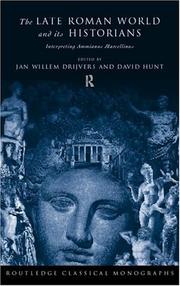
ISBN: 1280026006 9786610026005 0203024893 0203170911 9780203170915 9780203024898 041520271X 9780415202718 9781280026003 6610026009 9781134631742 9781134631780 9781134631797 9780415642330 Year: 1999 Publisher: London New York Routledge
Abstract | Keywords | Export | Availability | Bookmark
 Loading...
Loading...Choose an application
- Reference Manager
- EndNote
- RefWorks (Direct export to RefWorks)
Ammianus Marcellinus, Greek by birth but writing in Latin c. AD 390, was the last great Roman historian. His writings are an indispensable basis for our knowledge of the late Roman world. This book represents a collection of papers analysing Ammianus's writings from a variety of perspective, including Ammianus as historian of, and participant in, Julian's Persian campaign, his identification with traditional religious attitudes and values in Rome and his view of the Persian Magi. The contributors engage especially with the concept of self-identification. They address the tension of Ammianus'
Historians --- Greeks --- Emperors --- Czars (Emperors) --- Rulers --- Sovereigns --- Tsars --- Tzars --- Kings and rulers --- Ethnology --- Mediterranean race --- Historiographers --- Scholars --- History. --- Ammianus Marcellinus --- Ammien Marcellin --- Contributions in history of late Roman Empire. --- Rome --- History --- Historiography. --- Historians - Rome - Biography. --- Greeks - Rome - Biography --- Emperors - Rome - Biography - History and criticism.
Book
ISBN: 9789004174382 9004174389 9786612949555 9004193227 1282949551 9789004193222 Year: 2010 Volume: 319 Publisher: Leiden Boston
Abstract | Keywords | Export | Availability | Bookmark
 Loading...
Loading...Choose an application
- Reference Manager
- EndNote
- RefWorks (Direct export to RefWorks)
In this collection of essays Roman historical and biographical texts are studied from a literary point of view. The main interest of the author, Daniël den Hengst, professor emeritus of Latin at the University of Amsterdam, concerns the development of Roman historiography, the ways in which Roman historians present their work and the intertextual relations between these works and other literary genres. Special attention is given to the Historia Augusta and Ammianus Marcellinus, but also authors from the classical period, such as Cicero, Livy and Suetonius and their ideas about historiography are discussed. The articles demonstrate that a detailed interpretation of these texts in the original language is indispensable to understanding the aims and methods of ancient historians and biographers.
Emperors --- Empereurs --- Biography --- History and criticism. --- Biographies --- Histoire et critique --- Hengst, Daniël den. --- Ammianus Marcellinus. --- Scriptores historiae Augustae. --- Rome --- History --- Historiography. --- Histoire --- Historiographie --- History and criticism --- Hengst, Daniël den --- Scriptores historiae Augustae --- Historiography --- Hengst, Daniël den. --- Histoire auguste. --- Rulers --- Sovereigns --- Heads of state --- Kings and rulers --- Monarchy --- Biography&delete& --- Den Hengst, Daniël --- Hengst, D. den --- Hengst, Daan den --- Historiae Augustae scriptores --- Historia Augusta --- Storia augusta --- Istoria Augustă --- Augustan history --- Histoire Auguste --- Historiae Augustae --- HA --- Vlasteliny Rima --- Hisṭoryah Ogusṭah --- Czars (Emperors) --- Tsars --- Tzars --- Biography&delete&&delete& --- Emperors - Rome - Biography - History and criticism --- Rome - History - Empire, 284-476 - Historiography
Book
ISBN: 3110296934 3110297086 Year: 2013 Publisher: Berlin ; Boston : Walter de Gruyter GmbH,
Abstract | Keywords | Export | Availability | Bookmark
 Loading...
Loading...Choose an application
- Reference Manager
- EndNote
- RefWorks (Direct export to RefWorks)
Ammian gilt als der größte Historiker der Spätantike. Doch seine geographisch-ethnographischen Exkurse über Gallien, Ägypten, Persien und über nomadische Fremdvölker wie Sarazenen, Alanen und Hunnen wurden lange als imitierte Gelehrsamkeit und überflüssige Unterbrechung des Geschichtsverlaufs unterschätzt. In den klassischen Lehren der Rhetorik, der metaphorischen Lesung der Landschaften, der Konstituierung von Erinnerungsräumen und Gegenwelten zum Imperium Romanum deckt die Autorin den Schlüssel für das Verständnis des Gesamtwerks auf: Geschichtsverständnis und Diskurse über geographisches Wissen bedingen einander. Dadurch erscheint auch Ammians schriftstellerische Leistung in einem neuen Licht. So gewinnt der Leser einerseits eine Fülle von gesichertem Forschungswissen über die unbekannten ,Ränder der antiken Welt' und nimmt andererseits die Exkurse nicht länger als schmückendes Beiwerk der Haupthandlung wahr, sondern als sinnkonstituierende Partien innerhalb dieser.
Literature and history --- Rhetoric, Ancient --- Landscapes in literature. --- Metaphor in literature. --- Geographical perception --- Ethnology --- Public spaces --- Memory --- Retention (Psychology) --- Intellect --- Psychology --- Thought and thinking --- Comprehension --- Executive functions (Neuropsychology) --- Mnemonics --- Perseveration (Psychology) --- Reproduction (Psychology) --- Public places --- Social areas --- Urban public spaces --- Urban spaces --- Cities and towns --- Cultural anthropology --- Ethnography --- Races of man --- Social anthropology --- Anthropology --- Human beings --- Environmental perception --- Maps, Mental --- Mental maps --- Perceptual cartography --- Perceptual maps --- Perception --- Orientation (Psychology) --- Space perception --- Landscape in literature --- Ancient rhetoric --- Classical languages --- Greek language --- Greek rhetoric --- Latin language --- Latin rhetoric --- Study and teaching --- History --- History. --- Social aspects --- Rhetoric --- Ammianus Marcellinus. --- Rome --- Historiography. --- Res Gestae. --- Roman Empire.
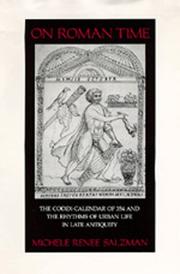
ISBN: 1282355457 0520909100 9786612355455 0585139881 9780520909106 9780585139883 0520065662 9780520065666 Year: 1990 Volume: 17 Publisher: Berkeley: University of California press,
Abstract | Keywords | Export | Availability | Bookmark
 Loading...
Loading...Choose an application
- Reference Manager
- EndNote
- RefWorks (Direct export to RefWorks)
Because they list all the public holidays and pagan festivals of the age, calendars provide unique insights into the culture and everyday life of ancient Rome. The Codex-Calendar of 354 miraculously survived the Fall of Rome. Although it was subsequently lost, the copies made in the Renaissance remain invaluable documents of Roman society and religion in the years between Constantine's conversion and the fall of the Western Empire. In this richly illustrated book, Michele Renee Salzman establishes that the traditions of Roman art and literature were still very much alive in the mid-fourth century. Going beyond this analysis of precedents and genre, Salzman also studies the Calendar of 354 as a reflection of the world that produced and used it. Her work reveals the continuing importance of pagan festivals and cults in the Christian era and highlights the rise of a respectable aristocratic Christianity that combined pagan and Christian practices. Salzman stresses the key role of the Christian emperors and imperial institutions in supporting pagan rituals. Such policies of accommodation and assimilation resulted in a gradual and relatively peaceful transformation of Rome from a pagan to a Christian capital.
Calendar, Roman. --- Rome - Religious life and customs. --- Related Historical Sciences --- History & Archaeology --- Calendars & Chronologies --- Rome --- Social life and customs. --- Religious life and customs. --- Calendar [Roman ] --- Calendrier romain --- Kalender [Romeinse ] --- Calendar, Roman --- -Roman calendar --- Social life and customs --- Religious life and customs --- Vie religieuse --- Moeurs et coutumes --- Rome - Social life and customs. --- HISTORY / Ancient / General. --- Rome - Social life and customs --- Rome - Religious life and customs --- 354. --- ammianus marcellinus. --- ancient rome. --- ancient world. --- antiquity. --- assimilation. --- catholic church. --- christian capital. --- christian emperors. --- christian rome. --- christianity. --- church history. --- codex calendar. --- constantine. --- conversion. --- early church. --- fall of rome. --- festivals. --- history. --- holidays. --- nonfiction. --- pagan cults. --- pagan rome. --- pagan. --- paganism. --- pre julian calendar. --- religion. --- religious freedom. --- religious studies. --- roman art. --- roman calendar. --- roman empire. --- roman literature. --- roman society. --- urban rome. --- western empire. --- Roman calendar --- Rites et cérémonies --- Rites et cérémonies
| Listing 1 - 10 of 10 |
Sort by
|

 Search
Search Feedback
Feedback About UniCat
About UniCat  Help
Help News
News